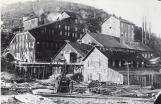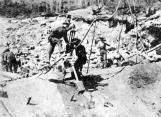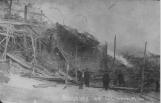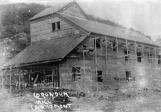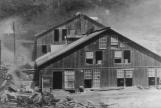1
The Craigmont MineIn 1876, Corundum crystals (Aluminum Oxide AL2O3) were discovered by Annie and her father Henry Robillard on the mountain near their home (referred to as 'Robillard Mountain') as they were looking for cranberries on the flats of Conroy’s Marsh of the York River. Corundum is one of the hardest minerals on earth, second only to diamonds. It was an abrasive and used to cut and polish steel and a hardener in the making of steel wheels for locomotives and train cars. Due to its unique qualities, corundum was also used for grinding optical lenses.
In 1899, the newly formed Canadian Corundum Company leased the mining rights to 1,400 acres and began to develop the site at what would later be known as 'Craigmont'. The first mill was a pilot project, which started in April 1900 and produced 20 tons of ore per day. It proved to be a success and in February 1904 a new larger mine was opened. It was the largest ore-concentrating mill in Canada with a capacity of 300 tons per day. The crushing mills were the heaviest and most powerful ever built in North America. The ore was drilled from the rock at the top of the mountain and transported by stone boat to a tramway that fed into the processors. The mine used 25 to 30 bush cords of wood every 24 hours in its’ three boilers to produce steam for drilling the rock and operate the concentrators. The finished product was a 75-100 pound canvas bag filled with 'sand like' ore. A short rail line was built on some of the tailings to a loading dock for boats on the York River. There were two wooden sheds there to store the bags of corundum until the steamers arrived. The ore was then transported to Barry’s Bay by boat and barge such as steamers 'Mayflower', 'Ruby' and 'Geneva'. It was then loaded onto boxcars of the Canada Atlantic Railway and shipped to England, Germany, Belgium, France and the USA. In 1906, the mill produced 2,914 tons and sold for $209,973 - equivalent to over $30 million today. Canadian grain corundum sold for $220 per ton or equivalent to $10 per pound today.
3
Craigmont was named after Benjamin Alexander Craig, the Vice President and first General Manager of the company. The neighbouring sister mine 'Burgess' was named after his wife’s maiden name. The miners worked at both mines and ore was processed at one or another mine to even out each mill’s capacity. Craigmont had seven managers in six years. Some were H. E. Haultain, D. A. Brebner, Mr. Bartlett, E. B. Clarke and Mr. Roche. The mine company was reorganized several times and had other names such as Manufacturer’s Corundum Company in 1909, Corundum Ltd. in 1918 and War-Time Metals Corporation in 1944.The mine at its peak in 1906 employed over 400 men, many emigrated from Europe due to a shortage of local workers. The town had 2000 people living in boarding houses and single homes. The miners earned $1.50 a day working a twelve-hour shift. The town site was divided into two sections - 'lower town' near the mill and 'upper town' about ¼ mile away to the west. The town had a community hall complete with stage, general store, church, post office, school, two tailors, surgeon, professional photographer, and a telephone system. The homes were frame construction and had five rooms and a summer kitchen at the back. There was also a stage coach traveling to Combermere three times per week.
6
On February 3, 1913, a fire completely destroyed the mill. Some say that frozen dynamite was stored near the boilers and the blasting caps were nearby and a spark from the boiler ignited the caps. Mr. Canon, a blacksmith died while shoeing a horse near by and Seymour Henry was blown off his feet and ruptured his eardrums from the blast. He was never able to hear again. The cost to replace the mill in 1913 dollars was estimated to be $500,000 so it was never rebuilt. The mine operation was then transferred to the Burgess Mine and another mill in Jewellville, near Palmer Rapids. However, a smaller mine operator came in and worked the tailings until June 1921 and a new mill building was built for this purpose. They reprocessed 25,580 tons of tailings from which 755 tons of graded grain was produced from 1918 to 1921 under the name Corundum Ltd.9
In 1944, with a new demand for the ore for industries during WWII, a new mine building was constructed in May of that year and corundum was milled until 1946 producing 200 tons a day from the tailings. Bill Kelly was the boss.The mine consisted of a drilled horizontal mine of approximately 220 feet into Robillard Mountain as well as several 'open pit' sites up the side of the mountain. The mine is now home to thousands of bats. These sites can be easily explored today. As well, several concrete and stone construction partial buildings can be seen.
There were four fatalities at the mine in the early years. They were Bill Tracey, Mr. Mulfantine in 1908, Mr. Canon in February 1913 and Jim Regan on July 27, 1946.
Today, Craigmont and Burgess Mines are essentially ghost towns. There is only one of the original buildings left at Craigmont and that is a stable once owned by the Regan family and now home to a reclusive monk. After the mine closed, many of the miners and families went north to other mine areas such as Cobalt and the homes were either destroyed or moved nearby.
This is the story of the once largest corundum mine in the world!
11
The Burgess Mine StoryIn 1902, the Ontario Corundum Company took up the Burgess Mine on Lot 14, Concession 14, Carlow Twp. originally investigated by W. F. Ferrier, a Lithologist. He was with the Geological Survey of Canada. In that first year ore was hand sorted and processed by a small blade crusher and produced 15% corundum for shipment to the USA for further concentration.
The next year a new mill was built but it burned in 1904 and was replaced by a larger structure with a lot of heavy processing equipment. Power was supplied by a 75 H.P. horizontal boiler using vast amounts of locally cut wood. From the mine cut, carts hauled the ore to the mill by a steam tractor for processing. All the processed ore was teamed to a wharf on the York River during summer months to be transported by the steamer 'Mayflower' towing barges with bags of processed corundum and other steamer boats to the rail depot at Barry’s Bay. In the winter the ore was placed in cages and sleighs and transported up the frozen York River to the Palmer Rapids road and then onto the old Barry’s Bay road to the hamlet of Halfway. There, the team of horses and driver changed before taking the corundum to the train in Barry’s Bay. Halfway got it’s name because it was halfway from Craigmont/Burgess Mines to Barry’s Bay. Many people believe to this day it was halfway between Combermere and Barry’s Bay, which is incorrect.
13
There was a small community near Burgess Mill where many of the workers and families lived. Many more workers who lived in other parts of Carlow Township would walk to their homes on days off and boarded in the community during the week. Approximately 150 miners worked in the mine and mill operation.There were some fatalities at the Burgess Mine. In 1915 Martin Canon was killed in an explosion in the plant boiler room while he was shoeing a horse. Two years later John Young died accidentally when his deer rifle discharged piercing his chest cavity as he hunted near the mine.
As an indication of how great a gamble farming was in those days, one night 25 sheep from a homesteader were either killed by wolves or so badly mauled they had to be destroyed. Foxes were a constant threat to both chickens and turkeys and a family lost a horse struck by lightning.
